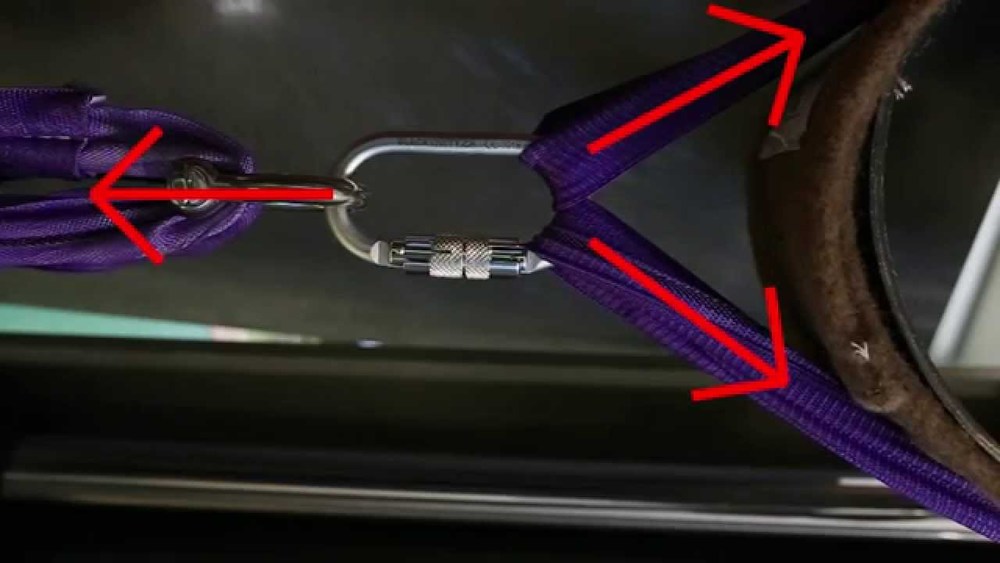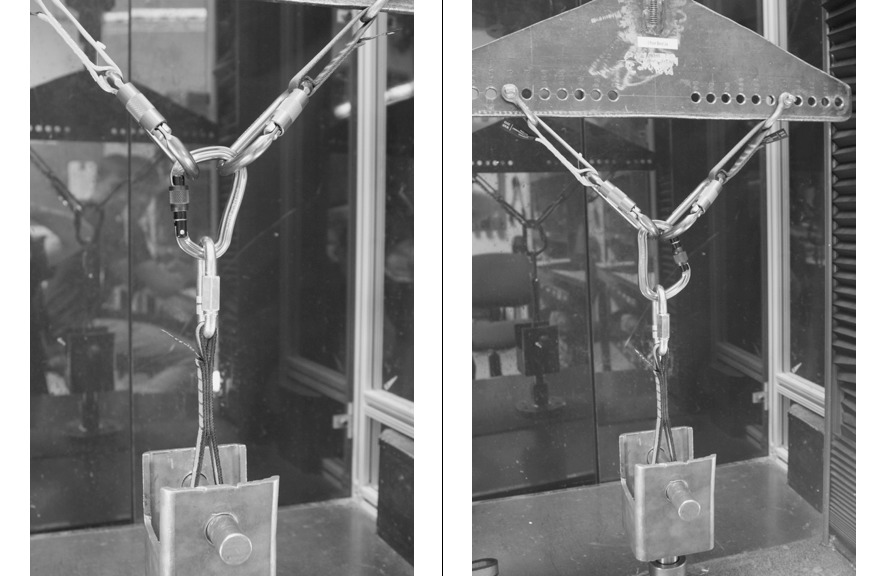Thoughts on "Triaxial loading of a belay loop, waist belt, leg loops"?
|
|
I recently had a heated discussion with a gym employee about girth hitching daiseys, tying in to JUST the belay loop VS. tying into Loop, waist leg loops. He gave me some bullshit about triaxial loading, but true triaxial loading would constitute 3 HARD contact points in my opinion. A belay loop, waist belt and leg loops hardly meet the criteria in that regard, as you have 3 soft radius'ed points of contact ,arguably distributing the load. Why in the hell would you bypass 3 good points of anchorage for a 3 into one scenario? If that loop fails, you are down for the dirt nap. |
|
|
Just use your harness the way the manufacturer tells you to. It's not a hard concept to get your head around. |
|
|
You guys are both wrong. Triaxial loading is pulling a single object (carabiner) in three different directions. Not three objects in one direction. Like you posted, a daisy pulling up three loops. Secondly, it you're hitching the waist and leg loops. The belay loop is a nothing burger. If by some chance the waist and leg loops fail the belay loop isn't attached to anything but the daisy. Either girth hitch the belay loop or waist and leg loops. There's no reason to hitch all three. While it doesn't cause any harm it adds absolutely no value at all. Third, I'd be more worried about breaking the daisy not the harness. Edit: by you guys I mean the two in the original post. |
|
|
I'm not clear on who is arguing what, so can't tell if I disagree or agree with your outrage. I have noticed this though: In 8/10 conversations about mechanics at the climbing gym, Newton would be disappointed. (Not MP forums though, they're quite good. Spout your ill-informed opinions here and someone will object, hell spout the truth and someone will object too. Our endless attacks on each others ideas is quite the way to filter out the crap ones :). |
|
|
The real reason not to put it on the belay loop is because it locks the belay loop in a single location and can cause alot of accelerated damage to it. http://rockandice.com/climbing-gear-tips/whats-the-correct-way-to-girth-hitch-to-your-harness/ Using it once in a while on it would not likely be a problem. Triaxial loading isn't possible between the belay loop and a girth hitch. Here is a sample of triaxial loading. |
|
|
the recommendation from the folks at Rigging-for-Rescue is to hitch your personal anchor (daisy, purcell prusik, whatever) through the tie-in points of your harness. the hitch follows the same path as the belay rope when you tie in. they argue that hitching the belay loop alone fixes the personal anchor on one point of the belay loop, and causes wear at that point. some suspect that this was the cause of Todd Skinner's belay loop failure. The tie-in points of modern harnesses are reinforced against such wear with layers of webbing or plastic. R4R uses the mnemonic cue: nylon on nylon - tie in points; metal on nylon - belay loop. |
|
|
Curt Haire wrote: It doesn't cause wear at that point, it causes wear at the point opposite the girth hitch, i.e. wear on the belay loop where it abraids against the two harness loops under load. Curt Haire wrote: It wasn't suspected, but rather the actual cause of the accident. That said, it should be noted it was a heavily-worn ultralight harness he knew needed replacing. |
|
|
John Wilder wrote: Depends on the gym. If you go to a gym where you don't tie into the rope and they have biners fixed to the rope you will tie into the belay loop. Are you sure what you are talking about was girth hitching daiseys on the belay loop? It would make sense for a gym to tell you to clip the rope using a fixed biner into the belay loop because if you were to clip it into the harness tie-in points that would cause triaxial loading. |
|
|
Your first mistake was attempting a technical conversation with a gym employee. They are mostly college kids with little more experience than most of the people on the top rope wall. I wouldent bother wasting my time. Just say "sure, thanks for the info bro" and move on doing your thing exactly as you were doing before. There is no such thing as triaxial loading of a belay loop, your understanding of it being bullshit is correct. |
|
|
Ah. The mythical tri axial loading. How fun. This is one of the more bogus claims and misused terms, second to “SHOCK LOAD”. Scary. With soft goods on soft goods, it is a non issue. With a carabiner and soft goods, it is borderline non issue. If you are one of those guys that still feels the need to put your belay biner through the tie in points instead of the belay loop, well, it’s silly. The belay loop is there for a reason. But if you must, the belay biner might be loaded in three different directions like the photo above. Ah, tri axial loading. But, you are not going to break the biner even in a big fall, especially with a locking biner where the gate can’t open if you locked it. Gym boy doesn’t know shit. Just flexing his quasi authority muscle. The real question is why the hell are you using a daisy in the gym? |
|
|
When I clip into the auto-belay at the gym I always clip the harder way, through both tie in points - it makes me think and check that I'm clipped in, and it pisses off the gym employee gumbies -) As far as tri loading the biner -- not going to happen with soft webbing in this application. Plus I'm old school - Whats a belay loop? |
|
|
My main concern is the tri-axial loading of my balls that occurs if I girth hitch anything to my tie-in points as it pulls the points tight together. The easy solution is to girth your sling/PAS to your belay loop, just take it off each time you're done climbing (since you probably don't need it on in many cases), thus eliminating the concern of wearing one point. |
|
|
Dante L wrote: Since when is soft webbing not going to cause triaxial loading? That is pretty much where all climbing triaxial loading comes from. You also have the problem with when a biner is going through the tie in points that the biner doesn't rotate freely like on the belay load and when someone falls and flips on their back could cause the cross loading on the biner. Given when people tie in with a biner you are normally top roping and none of this is likely to cause the force needed to cause a failure. If you are sharing ropes for multi pitch and have someone tying into the middle of a rope because you don't have enough ropes than I think the risk of putting a biner and causing a triaxial / cross loading failure is a small risk you should consider. Still extrememly unlikely but alot more can happen outdoors following a multi pitch route that could go all over the place vs a route designed to be top roped. |
|
|
Yes tri-axial loading reduces the strength of the biner. No you still probably aren't going to break it. However, there's really no good reason to tri-axially load your biner by clipping it to the tie-in points instead of the belay loop, so you might as well just avoid the tri-axial loading. To the OP, tri-axial loading doesn't really matter when you're talking about soft goods. The concern is with tri-axially loading a carabiner. |
|
|
Dante L wrote: Locking biner through one tie-in point *and* the belay loop - might as well redundantly confuse the gumby... |
|
|
Jake Jones wrote: That counts as a thought. |
|
|
ViperScale . wrote: The picture above is biaxial loading. You could tie or attach as many dingles to the biner and as long as they are in the same plane, it is biaxial loading. An example of triaxial loading would be if the biner was on an edge of a cliff. You'd then have forces in x,y, and z. The non technical advise in the thread is spot on.... Don't argue with the kiddos in the gym. |
|
|
Randy Sandoval wrote: stop |
|
|
ConorCarroll wrote: Lol you don't know what triaxial loading means. This is a picture of triaxial loading test from BD. It is identical as the picture above. There is pull on the biner in 3 different directions aka triaxial. It doesn't matter what direction the ground is because gravity isn't going to matter compared to the pull in the 3 directions of the pieces attached to the biner. And yes if you notice in the test at the top there are more than one hole for them to widden or shrink the district to make the angle different because the bigger the angle the more it will weaken the biner. |
|
|
ViperScale . wrote: I understand triaxial forces. I've stamped triaxial stress analysis before. I think black diamond does as well. Who doesn't understand it is most of the climbing community - which your posts have made more apparent to me and something black Diamond understood long before I did. Again, what is shown above is biaxial loading in a true engineering sense. Forces along 2 axes. Yes, calculator and protractor needed for most to calculate. For those who have rusty physics and trig skills, you refer to the above as “triaxial. " What I've learned is similar to the advice I reiterated, don't argue with the kids on an online forum. As long as someone understands the forces in a 2nd direction can change the amount of force on a piece of gear, they can call it whatever they like... Misnomer or not. |
|
|
ViperScale . wrote: ConorCarroll wrote: Oh, sooo sorry, Conor. Viper got more thumbs up. So, he is correct. Or is he? Sorry Viper. Just cause you can copy and paste a photo from BD doesn't make you correct. Soooo sorry. You are incorrect. Nice job Conor. Way to point out the error in the so called Triaxial loading. It is mostly a fallacy. If you remove tension from point A the tension between point B and C are minimal and irrelevant. Thus, there is loading along 2 axes. This is biaxial loading, despite the incorrect nomenclature found in the climbing community. lol. Viper doesn't know what biaxial loading is. |

 Continue with onX Maps
Continue with onX Maps Sign in with Facebook
Sign in with Facebook


























